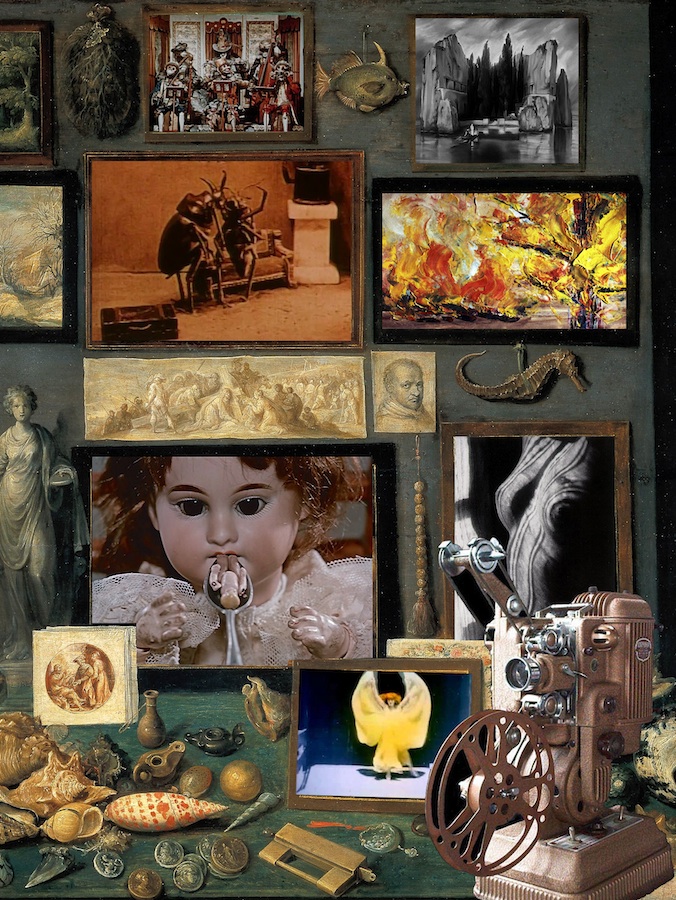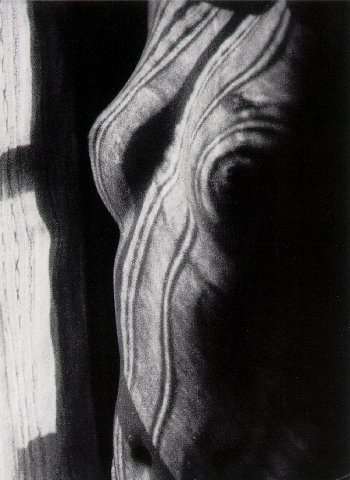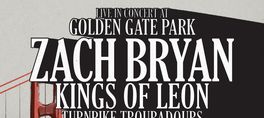Oddball Films and guest curator/ filmmaker John Cannizzaro present Smokehouse Films' Cinematic Cabinet of Wonders – a compendium of rare & remarkable, strange & wonderful 16mm film gems from the archives of Smokehouse Films. This unique mix of films includes early works by animation masters Jan Svankmajer’s Jabberwocky (Czech 1971) – loosely based on the poem by Lewis Carroll; and Ladislas Starevich’ Revenge of the Kinematograph Cameraman (Russia/Poland 1912) - a cynical work about infidelity and jealousy among the insects. Playful, experimental visions erupt with a vengeance in an early work by Gus Van Sant, Little Johnny and his Dog (1972) and in artist/photographer Man Ray’s first film Le Retour a la Raison (1923) one of the first Dadaist films ever made. Narrative expressed through paint in motion is seen in Witold Giersz’ Fire (Poland 1975) who has described his art as an attempt at "bringing painting to life" and in the masterful hand of Norman McLaren, whose Little Phantasy on a 19th Century Painting (Canada 1946) brings a painting by Boecklin to life. “Science” makes an appearance in the early silent, oddity The Fly Juggler (Tolhurst c. 1920s) in which we see a fly “juggle” a ball, as well as in some exotic, ethnography from around the globe with the San Bushmen of the Kalahari, some praying pigs, the Serpentine Dance, the Afghan national sport, and a PSA by Simpson’s creator Matt Groening’s father Homer Groening, Man and his World (1969). Curator John Cannizzaro will also present a new cine-poem made with his son Laszlo on the ever changing father/son relationship, The Son Also Rises (2012) as well as other surprises.
Date: Friday, July 25th, 2014 at 8:00pm
Venue: Oddball Films, 275 Capp Street San Francisco
Admission: $10.00 Limited Seating RSVP to [email protected] or (415) 558-8117
Web: http://oddballfilms.blogspot.com
Highlights include:
Revenge of the Kinematograph Cameraman (aka The Cameraman's Revenge) (B+W, 1912, Vladislav Starevich)
A cynical work about infidelity and jealousy among the insects. Vladislav Starevich was a Russian and French stop-motion animator notable as the author of the first puppet-animated film (i.e. The Beautiful Lukanida (1912).
The Fire (Color, 1975, Witold Giersz)
A fire breaks out in a forest inhabited by many animals. A painting vision created in a technique similar to the method used in realization of the movie "Horse". Witold Giersz has described his art as an attempt at "bringing painting to life". He declares that he isn’t the kind of director-animator that tries to give some sort of philosophical meaning to his films at all costs. According to him, animated films are chiefly defined by the use of plastic arts, though a good plastic artist might as well be a philosopher. Giersz regards himself as a discoverer of a new animation technique, which "involves animating with a paintbrush in front of a film camera".
Le Retour a la Raison (B+W, 1923, Man Ray)
A lush and hypnotic experimental film in which white specks and shapes gyrate over a black background, a light-striped torso, and a spinning egg crate - It consists of animated textures, Rayographs and the torso of Kiki of Montparnasse. One of the first Dadaist films and the first film made by Man Ray when he relocated to Paris.
Annabelle Serpentine Dance (B+W, 1895)
A short silent American film produced and distributed by Edison Manufacturing Company in 1895. It is one of several released by the studio in the late 19th century. Each short film depicts the popular serpentine dance performed by Annabelle Moore. Many of the prints were distributed in color, which was hand-tinted.
Jabberwocky (Color, 1971, Jan Svankmajer)
Legendary Czech animator Jan Svankmajer's stop-motion films combine creepiness and wit in a way no one has ever accomplished. His penchant for object-animation has led to living dolls, dancing meat and baby tree-demons. In Jabberwocky, Svankmajer's first adaptation of Lewis Carroll's world, described by the director as "a Freudian record of the development of a child through all its stages: through homosexuality and Sado-Masochism to rebellion against the father" - !!
A Little Phantasy on a Nineteenth Century Painting (Color, 1946, Norman McLaren)
After the war, Norman McLaren made A Little Phantasy on a Nineteenth Century Painting, a frame by frame animated film based on a pastel reproduction of this painting by Boecklin with a black background. The peaceful island is turned into the backdrop of a nightmare. A Little Phantasy on a Nineteenth Century Painting is very different from the most well-known works by Norman McLaren: the abstract animated drawings with twirling shapes scratched directly onto the film.
About the curator:
John Cannizzaro grew up in New England where he made several short films before relocating to Los Angeles in 1990. There he completed his first mini feature, Critical Mass, which was reviewed by Paul Malcolm in the Nov. 22, 1996 LA Weekly as a “low key tale of guttersnipe mysticism…Critical Mass is heavy on mood and symbolism with Cannizzaro drawing some beautiful compositions…What’s most intriguing about the film is the connection it makes between spiritualism and ennui”. Still working primarily in Super 8 film, he has completed several more short films including “Gulliver’s Travels” and “50 Feet That Shook The World” (both made for LA Flicker’s ‘Attack of the 50 Foot Reels’ which have played in festivals around the world) as well as a full-length feature film “The Left Hand Path”. He is also the founder of Smokehouse Films – a film production company and an ever increasing archive of rare ethnographic, experimental, and unique 16mm films.
show less
Date: Friday, July 25th, 2014 at 8:00pm
Venue: Oddball Films, 275 Capp Street San Francisco
Admission: $10.00 Limited Seating RSVP to [email protected] or (415) 558-8117
Web: http://oddballfilms.blogspot.com
Highlights include:
Revenge of the Kinematograph Cameraman (aka The Cameraman's Revenge) (B+W, 1912, Vladislav Starevich)
A cynical work about infidelity and jealousy among the insects. Vladislav Starevich was a Russian and French stop-motion animator notable as the author of the first puppet-animated film (i.e. The Beautiful Lukanida (1912).
The Fire (Color, 1975, Witold Giersz)
A fire breaks out in a forest inhabited by many animals. A painting vision created in a technique similar to the method used in realization of the movie "Horse". Witold Giersz has described his art as an attempt at "bringing painting to life". He declares that he isn’t the kind of director-animator that tries to give some sort of philosophical meaning to his films at all costs. According to him, animated films are chiefly defined by the use of plastic arts, though a good plastic artist might as well be a philosopher. Giersz regards himself as a discoverer of a new animation technique, which "involves animating with a paintbrush in front of a film camera".
Le Retour a la Raison (B+W, 1923, Man Ray)
A lush and hypnotic experimental film in which white specks and shapes gyrate over a black background, a light-striped torso, and a spinning egg crate - It consists of animated textures, Rayographs and the torso of Kiki of Montparnasse. One of the first Dadaist films and the first film made by Man Ray when he relocated to Paris.
Annabelle Serpentine Dance (B+W, 1895)
A short silent American film produced and distributed by Edison Manufacturing Company in 1895. It is one of several released by the studio in the late 19th century. Each short film depicts the popular serpentine dance performed by Annabelle Moore. Many of the prints were distributed in color, which was hand-tinted.
Jabberwocky (Color, 1971, Jan Svankmajer)
Legendary Czech animator Jan Svankmajer's stop-motion films combine creepiness and wit in a way no one has ever accomplished. His penchant for object-animation has led to living dolls, dancing meat and baby tree-demons. In Jabberwocky, Svankmajer's first adaptation of Lewis Carroll's world, described by the director as "a Freudian record of the development of a child through all its stages: through homosexuality and Sado-Masochism to rebellion against the father" - !!
A Little Phantasy on a Nineteenth Century Painting (Color, 1946, Norman McLaren)
After the war, Norman McLaren made A Little Phantasy on a Nineteenth Century Painting, a frame by frame animated film based on a pastel reproduction of this painting by Boecklin with a black background. The peaceful island is turned into the backdrop of a nightmare. A Little Phantasy on a Nineteenth Century Painting is very different from the most well-known works by Norman McLaren: the abstract animated drawings with twirling shapes scratched directly onto the film.
About the curator:
John Cannizzaro grew up in New England where he made several short films before relocating to Los Angeles in 1990. There he completed his first mini feature, Critical Mass, which was reviewed by Paul Malcolm in the Nov. 22, 1996 LA Weekly as a “low key tale of guttersnipe mysticism…Critical Mass is heavy on mood and symbolism with Cannizzaro drawing some beautiful compositions…What’s most intriguing about the film is the connection it makes between spiritualism and ennui”. Still working primarily in Super 8 film, he has completed several more short films including “Gulliver’s Travels” and “50 Feet That Shook The World” (both made for LA Flicker’s ‘Attack of the 50 Foot Reels’ which have played in festivals around the world) as well as a full-length feature film “The Left Hand Path”. He is also the founder of Smokehouse Films – a film production company and an ever increasing archive of rare ethnographic, experimental, and unique 16mm films.
Oddball Films and guest curator/ filmmaker John Cannizzaro present Smokehouse Films' Cinematic Cabinet of Wonders – a compendium of rare & remarkable, strange & wonderful 16mm film gems from the archives of Smokehouse Films. This unique mix of films includes early works by animation masters Jan Svankmajer’s Jabberwocky (Czech 1971) – loosely based on the poem by Lewis Carroll; and Ladislas Starevich’ Revenge of the Kinematograph Cameraman (Russia/Poland 1912) - a cynical work about infidelity and jealousy among the insects. Playful, experimental visions erupt with a vengeance in an early work by Gus Van Sant, Little Johnny and his Dog (1972) and in artist/photographer Man Ray’s first film Le Retour a la Raison (1923) one of the first Dadaist films ever made. Narrative expressed through paint in motion is seen in Witold Giersz’ Fire (Poland 1975) who has described his art as an attempt at "bringing painting to life" and in the masterful hand of Norman McLaren, whose Little Phantasy on a 19th Century Painting (Canada 1946) brings a painting by Boecklin to life. “Science” makes an appearance in the early silent, oddity The Fly Juggler (Tolhurst c. 1920s) in which we see a fly “juggle” a ball, as well as in some exotic, ethnography from around the globe with the San Bushmen of the Kalahari, some praying pigs, the Serpentine Dance, the Afghan national sport, and a PSA by Simpson’s creator Matt Groening’s father Homer Groening, Man and his World (1969). Curator John Cannizzaro will also present a new cine-poem made with his son Laszlo on the ever changing father/son relationship, The Son Also Rises (2012) as well as other surprises.
Date: Friday, July 25th, 2014 at 8:00pm
Venue: Oddball Films, 275 Capp Street San Francisco
Admission: $10.00 Limited Seating RSVP to [email protected] or (415) 558-8117
Web: http://oddballfilms.blogspot.com
Highlights include:
Revenge of the Kinematograph Cameraman (aka The Cameraman's Revenge) (B+W, 1912, Vladislav Starevich)
A cynical work about infidelity and jealousy among the insects. Vladislav Starevich was a Russian and French stop-motion animator notable as the author of the first puppet-animated film (i.e. The Beautiful Lukanida (1912).
The Fire (Color, 1975, Witold Giersz)
A fire breaks out in a forest inhabited by many animals. A painting vision created in a technique similar to the method used in realization of the movie "Horse". Witold Giersz has described his art as an attempt at "bringing painting to life". He declares that he isn’t the kind of director-animator that tries to give some sort of philosophical meaning to his films at all costs. According to him, animated films are chiefly defined by the use of plastic arts, though a good plastic artist might as well be a philosopher. Giersz regards himself as a discoverer of a new animation technique, which "involves animating with a paintbrush in front of a film camera".
Le Retour a la Raison (B+W, 1923, Man Ray)
A lush and hypnotic experimental film in which white specks and shapes gyrate over a black background, a light-striped torso, and a spinning egg crate - It consists of animated textures, Rayographs and the torso of Kiki of Montparnasse. One of the first Dadaist films and the first film made by Man Ray when he relocated to Paris.
Annabelle Serpentine Dance (B+W, 1895)
A short silent American film produced and distributed by Edison Manufacturing Company in 1895. It is one of several released by the studio in the late 19th century. Each short film depicts the popular serpentine dance performed by Annabelle Moore. Many of the prints were distributed in color, which was hand-tinted.
Jabberwocky (Color, 1971, Jan Svankmajer)
Legendary Czech animator Jan Svankmajer's stop-motion films combine creepiness and wit in a way no one has ever accomplished. His penchant for object-animation has led to living dolls, dancing meat and baby tree-demons. In Jabberwocky, Svankmajer's first adaptation of Lewis Carroll's world, described by the director as "a Freudian record of the development of a child through all its stages: through homosexuality and Sado-Masochism to rebellion against the father" - !!
A Little Phantasy on a Nineteenth Century Painting (Color, 1946, Norman McLaren)
After the war, Norman McLaren made A Little Phantasy on a Nineteenth Century Painting, a frame by frame animated film based on a pastel reproduction of this painting by Boecklin with a black background. The peaceful island is turned into the backdrop of a nightmare. A Little Phantasy on a Nineteenth Century Painting is very different from the most well-known works by Norman McLaren: the abstract animated drawings with twirling shapes scratched directly onto the film.
About the curator:
John Cannizzaro grew up in New England where he made several short films before relocating to Los Angeles in 1990. There he completed his first mini feature, Critical Mass, which was reviewed by Paul Malcolm in the Nov. 22, 1996 LA Weekly as a “low key tale of guttersnipe mysticism…Critical Mass is heavy on mood and symbolism with Cannizzaro drawing some beautiful compositions…What’s most intriguing about the film is the connection it makes between spiritualism and ennui”. Still working primarily in Super 8 film, he has completed several more short films including “Gulliver’s Travels” and “50 Feet That Shook The World” (both made for LA Flicker’s ‘Attack of the 50 Foot Reels’ which have played in festivals around the world) as well as a full-length feature film “The Left Hand Path”. He is also the founder of Smokehouse Films – a film production company and an ever increasing archive of rare ethnographic, experimental, and unique 16mm films.
read more
Date: Friday, July 25th, 2014 at 8:00pm
Venue: Oddball Films, 275 Capp Street San Francisco
Admission: $10.00 Limited Seating RSVP to [email protected] or (415) 558-8117
Web: http://oddballfilms.blogspot.com
Highlights include:
Revenge of the Kinematograph Cameraman (aka The Cameraman's Revenge) (B+W, 1912, Vladislav Starevich)
A cynical work about infidelity and jealousy among the insects. Vladislav Starevich was a Russian and French stop-motion animator notable as the author of the first puppet-animated film (i.e. The Beautiful Lukanida (1912).
The Fire (Color, 1975, Witold Giersz)
A fire breaks out in a forest inhabited by many animals. A painting vision created in a technique similar to the method used in realization of the movie "Horse". Witold Giersz has described his art as an attempt at "bringing painting to life". He declares that he isn’t the kind of director-animator that tries to give some sort of philosophical meaning to his films at all costs. According to him, animated films are chiefly defined by the use of plastic arts, though a good plastic artist might as well be a philosopher. Giersz regards himself as a discoverer of a new animation technique, which "involves animating with a paintbrush in front of a film camera".
Le Retour a la Raison (B+W, 1923, Man Ray)
A lush and hypnotic experimental film in which white specks and shapes gyrate over a black background, a light-striped torso, and a spinning egg crate - It consists of animated textures, Rayographs and the torso of Kiki of Montparnasse. One of the first Dadaist films and the first film made by Man Ray when he relocated to Paris.
Annabelle Serpentine Dance (B+W, 1895)
A short silent American film produced and distributed by Edison Manufacturing Company in 1895. It is one of several released by the studio in the late 19th century. Each short film depicts the popular serpentine dance performed by Annabelle Moore. Many of the prints were distributed in color, which was hand-tinted.
Jabberwocky (Color, 1971, Jan Svankmajer)
Legendary Czech animator Jan Svankmajer's stop-motion films combine creepiness and wit in a way no one has ever accomplished. His penchant for object-animation has led to living dolls, dancing meat and baby tree-demons. In Jabberwocky, Svankmajer's first adaptation of Lewis Carroll's world, described by the director as "a Freudian record of the development of a child through all its stages: through homosexuality and Sado-Masochism to rebellion against the father" - !!
A Little Phantasy on a Nineteenth Century Painting (Color, 1946, Norman McLaren)
After the war, Norman McLaren made A Little Phantasy on a Nineteenth Century Painting, a frame by frame animated film based on a pastel reproduction of this painting by Boecklin with a black background. The peaceful island is turned into the backdrop of a nightmare. A Little Phantasy on a Nineteenth Century Painting is very different from the most well-known works by Norman McLaren: the abstract animated drawings with twirling shapes scratched directly onto the film.
About the curator:
John Cannizzaro grew up in New England where he made several short films before relocating to Los Angeles in 1990. There he completed his first mini feature, Critical Mass, which was reviewed by Paul Malcolm in the Nov. 22, 1996 LA Weekly as a “low key tale of guttersnipe mysticism…Critical Mass is heavy on mood and symbolism with Cannizzaro drawing some beautiful compositions…What’s most intriguing about the film is the connection it makes between spiritualism and ennui”. Still working primarily in Super 8 film, he has completed several more short films including “Gulliver’s Travels” and “50 Feet That Shook The World” (both made for LA Flicker’s ‘Attack of the 50 Foot Reels’ which have played in festivals around the world) as well as a full-length feature film “The Left Hand Path”. He is also the founder of Smokehouse Films – a film production company and an ever increasing archive of rare ethnographic, experimental, and unique 16mm films.
show less
Date/Times:
275 Capp Street, San Francisco, CA 94110
The Best Events
Every Week in Your Inbox
From Our Sponsors
UPCOMING EVENTS
Great suggestion! We'll be in touch.
Event reviewed successfully.











